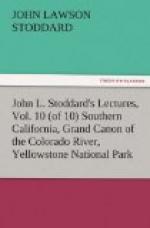The Indian name of this remarkable cliff is Katzimo, and the title Haunted Mesa would be a more appropriate translation of the Spanish name, Mesa Encantada, than Enchanted; for the people of Acoma believe its summit to be haunted by the spirits of their ancestors. A sinister tradition exists among them that one day, many centuries ago, when all the men of the village were at work upon the plain, a mass of rock, detached by the slow action of the elements, or else precipitated by an earthquake shock, fell into the narrow cleft by which alone an ascent or descent of the mesa was made, and rendered it impassable. The women and children, left thus on the summit of a cliff four hundred and thirty feet in height, and cut off from communication with their relatives and friends, who were unable to rejoin and rescue them, are said to have slowly perished by starvation, and their bones, pulverized in the course of centuries, are believed to have been, finally, blown or washed away. To test the truth of this tradition, at least so far as traces of a previous inhabitancy of the mesa could confirm it, Mr. Frederick W. Hodge, in 1895, made an attempt to reach the summit; but, though he climbed to within sixty feet of the top, he could on that occasion go no higher. He found, however, along the sides of the cliffs enormous masses of debris, washed down by the streams of water which, after a tempest, drain off from the summit in a thousand little cataracts. Not only did Mr. Hodge discover in this rubbish several fragments of Indian pottery, but he, also, observed certain holes in the cliff which seemed to him to have been cut there specially for hands and feet. These he believed to be traces of an ancient trail. Stimulated by the announcement of this discovery, Professor William Libbey, of Princeton College, in July, 1896, made the ascent of the Enchanted Mesa by means of a life line fired over the mound from a Lyle gun. Stout ropes having then been drawn over the cliffs and made secure, the adventurous aeronaut was actually hauled up to the summit in a boatswain’s chair, as sailors are sometimes pulled ashore from a sinking ship. On his descent, however, he declared that he had found nothing to indicate that the crest had ever been inhabited, or even previously visited. Nothing daunted by this statement, a few weeks later Mr. Hodge again attempted the ascent in which he had failed the year before. This time he was successful, and scaled the cliff by means of an extension ladder and several hundred feet of rope. But very different were the conclusions reached by him as to the probable authenticity of the tradition; for after having been on the mesa only a short time, he found a piece of ancient pottery, and, during a search of twenty hours, not only were several more fragments of earthenware discovered, but also two stone ax-heads, an arrow-point of flint, and part of a shell bracelet. Moreover, a little monument of stone, arranged with evident design, was found on the edge of the cliff. Mr. Hodge and his party concluded, therefore, that beyond a doubt the Mesa Encantada had once been inhabited, and that the legend of the destruction of its last occupants may be true.




